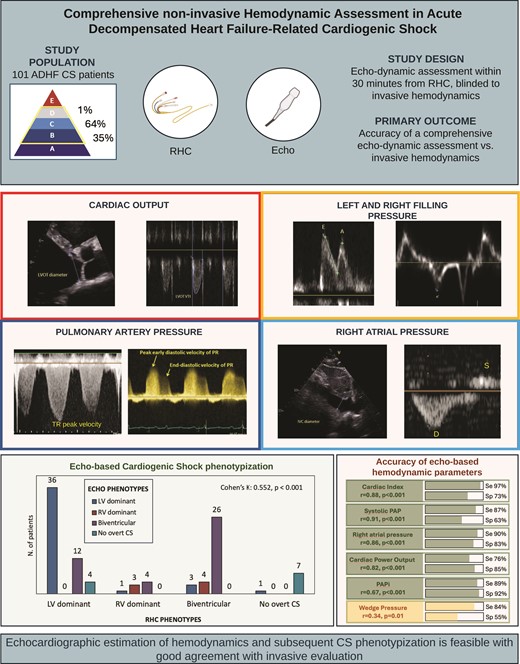-
Views
-
Cite
Cite
Simone Frea, Carol Gravinese, Paolo Boretto, Giulia De Lio, Pier Paolo Bocchino, Filippo Angelini, Marco Cingolani, Guglielmo Gallone, Antonio Montefusco, Eduardo Valente, Stefano Pidello, Claudia Raineri, Gaetano Maria De Ferrari, Comprehensive non-invasive haemodynamic assessment in acute decompensated heart failure-related cardiogenic shock: a step towards echodynamics, European Heart Journal. Acute Cardiovascular Care, Volume 13, Issue 9, September 2024, Pages 646–655, https://doi.org/10.1093/ehjacc/zuae087
Close - Share Icon Share
Abstract
Haemodynamic assessment can be determinant in phenotyping cardiogenic shock (CS) and guiding patient management. Aim of this study was to evaluate the correlation between echocardiographic and invasive assessment of haemodynamics in acute decompensated heart failure-related CS (ADHF-CS).
All consecutive ADHF-CS patients (SCAI shock stage ≥B) undergoing right heart catheterization (RHC) between 2020 and 2022 were prospectively enrolled. Patients underwent echocardiography 30 min before RHC. The evaluated haemodynamic parameters and their echocardiographic estimates (‘e’) comprised cardiac index (CI), wedge pressure (WP), pulmonary artery pressures (PAP), cardiac power output (CPO) and pulmonary artery pulsatility index (PAPi). Hundred and one ADHF-CS patients (56 ± 11 years, 64% SCAI shock stage C, left ventricular ejection fraction 29 ± 5%) were included. Good correlation was found for CI, systolic PAP, RAP, and CPO (Pearson r > 0.8 for all), moderate correlation for ePAPi (r = 0.67) and PVR (r = 0.51), while estimation of WP was weak. The sensitivity and specificity of eCI to identify low output state (CI ≤2.2 L/min/m2) were 0.97 and 0.73, respectively, those of eWP for elevated filling pressures (WP >15 mmHg) were 0.84 and 0.55, those of ePAPs for PAPs ≥35 mmHg were 0.87 and 0.63, those of eCPO for CPO <0.6 W were 0.76 and 0.85, those of ePAPi for PAPi <1.85 were 0.89 and 0.92. Echocardiographic phenotyping of CS showed a good agreement with invasive classification (K value 0.457, P < 0.001).
Echocardiographic estimation of haemodynamics and subsequent phenotypization of CS is feasible with good agreement with invasive evaluation.







Comments